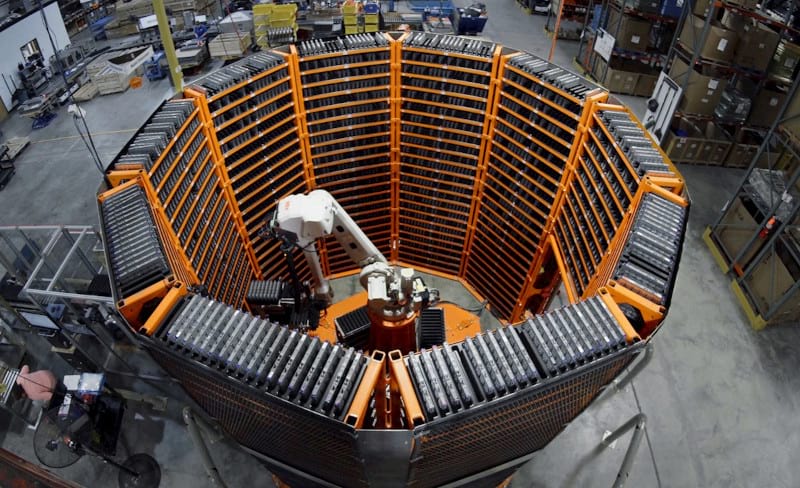The agility of ABB’s RobotStudio design software in modelling automated solutions to complex manufacturing problems has been amply demonstrated by a project for US automotive battery-pack remanufacturer Dorman Products Inc., which has resulted in a single ABB robot picking product from 5,000 different storage slots.
The robotic system has cut battery build time by 66 percent, Dorman reports, which translates as a 300 per cent increase in the plant’s daily output of finished battery-packs. Warranty returns have fallen by 27 percent.
With its focus on reassembling battery-packs for Toyota Prius hybrid drive vehicles, Dorman’s Sanford, NC, facility faced serious challenges in identifying the 28 different modules which, only in the right combination, will together create the optimal replacement battery. Previously, operators might have had to attempt matches with up to 100 refurbished modules, in a painstaking manual process of trial-and-error, before finding the best fit for a specific battery-pack.
“Customers were not having an acceptable experience with the product, orders were taking too long to fill and there were too many returns,” said Michael Menta, Dorman’s vice president of engineering. “We had to take a step back, evaluate the entire process from beginning to end and find out where the breakdowns were occurring.”
A partial automation of the process, with a focus on the front-end grading system for incoming modules, did not address the bottleneck of the matching operation either in terms of the speed of order fulfilment or the quality of the resulting battery-packs.
Menta and his team turned to Pennsylvania-based Production Systems Automation (PSA) to explore potential customised automation solutions. “We had no preconceived notion of what form an automated module-matching system would take, or if it was even possible,” he said.

PSA project engineer Chris Lesnefsky applied ABB’s RobotStudio simulation software to the problem, with no comparable end-use applications on which to base any solution.
“The simulations that can be created in RobotStudio are incredibly realistic, virtually identical to how a concept and its various components will perform on the factory floor,” he said. “I was able to experiment with various concepts, complete with accurate reads on reach, speed, distance, conveyor location, and so on, allowing us to optimize the layout and robot paths to achieve the best cycle times. RobotStudio is an incredible tool for system design, proof-of-concept and ultimately programming robots.”
The solution Lesnefsky hit upon, offering the best compromise between factory footprint and capacity, involved arranging 10 stacks of shelving housing up to 5,000 modules in a ‘decagon’ around a central ABB IRB 4600 six-axis industrial robot. The 40kg-payload robot, with a reach of 2.55m, can identify and retrieve modules from any storage slot through 360 degrees.
A linear slide on the robot arm ensures it can reach every position on the shelves, and the end-of-arm-tooling (EOAT) is equipped with a Schunk gripper and sensors to ensure handling is gentle and without collisions. Any module subject to impact has to be discarded.
To one side of the cell, there is an opening for a split-level, servo-operated conveyor. One belt brings modules in to be put into position in the module ‘library’, while the other removes modules which have been picked as probable matches within a specific battery-pack.
The robot can store or retrieve one module every eight seconds. The system typically runs for a total of 104 hours every week, divided into periods when the modules are being put into storage and other periods when target modules are being retrieved.
The ‘thinking’ part of the Dorman installation is just as important as the physical handling aspect. It consists of an ABB IRC 5 robot controller, which interfaces through a PLC with a LabVIEW software program.
As modules enter the storage area, a SICK Inspector camera scans the QR code to correlate the item’s entry date and grade with its storage location. The LabVIEW program stores this data and, critically, includes a feature which identifies likely good matches across each 28-module battery-pack. QR codes are also scanned on exiting the area.
“When the robot begins the matching process, the LabVIEW software program instructs the robot which modules to pull, and in which order they need to be pulled, based on the specifications of the specific order,” said Dorman’s Menta. “There are multiple proprietary parameters that pair the modules.”
Two modules go together to make a pair. Fourteen pairs make a pack. Each module must be perfectly matched with its partner, and all pairs must be perfectly matched with each other.
The software offers an additional, valuable advantage to Dorman in terms of inventory management. It monitors those modules which have sat idle for several months, or failed repeated matching attempts for battery-packs, and removes them from the storage area.
As well as establishing – with the help of RobotStudio – the optimal system configuration to automate the process, PSA was also instrumental in identifying the necessary system components and ensuring that communication across this system was complete and seamless, said Dorman. “The ABB IRC 5 robot controller interfacing with the PLC and the LabVIEW software program is the central brain of the operation,” Menta added.

